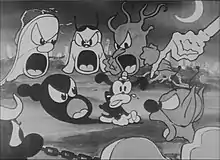| Swing You Sinners! | |
|---|---|
 Bimbo, surrounded by a haunted graveyard, attempts to escape. | |
| Directed by | Dave Fleischer |
| Produced by | Max Fleischer |
| Starring | Billy Murray |
| Animation by | Willard Bowsky Ted Sears George Cannata Shamus Culhane Al Eugster William Henning Seymour Kneitel Grim Natwick |
| Color process | Black and white |
Production company | |
| Distributed by | Paramount Publix Corporation |
Release date | September 24, 1930 |
Running time | 8 minutes |
| Language | English |
Swing You Sinners! is a 1930 animated cartoon short, produced by Fleischer Studios as part of the Talkartoons series.[1] The cartoon is notable for its surreal, dark, and abstract content.
Plot
Bimbo is seen late at night, trying to steal a chicken. After several attempts, he accidentally grabs a policeman by the hand. As he tries to walk away as if nothing happened the chicken follows him in spite of this, as does the policeman.
Eventually, the chicken and its chicks flee, while Bimbo enters a cemetery. To his horror, he finds out that it is haunted, complete with a host of ghosts and other supernatural beings who tell him that he will be punished for his sin, regardless of him begging for mercy and assurance that he has made efforts to become a better person. Throughout the rest of the film, Bimbo is reprimanded and pursued by them until he enters a large cave, whereupon the monsters sing about Bimbo's demise, and a huge skull devours him, ending the cartoon.
Background
The cartoon was released on September 24, 1930[2] in the Talkartoons series and animated by Ted Sears and Willard Bowsky.[3] George Cannata, Shamus Culhane,[4] Al Eugster,[5] William Henning, Seymour Kneitel and Grim Natwick also worked on it, but are uncredited in the title card.[6] The cartoon was animated by a completely new staff who had never worked in animation before, because the studio had to replace some animators who quit.[7] Animator Culhane states in his memoirs that though he created and animated what might be construed a Stereotyped caricature of "a Jew with a black beard, huge nose, and a derby", the studio's atmosphere and its mixed ethnic crew made the depiction completely acceptable to all the Jews in the studio.[8] The caricature in question is a reference to Jewish-American comedian Max Davidson.[9]
Reception
Motion Picture News wrote on October 11, 1930, that "the clever cartoon pen of Max Fleischer again demonstrates itself in this Talkartoon. An off-stage chorus sings the lyrics to the rhythm of the action and the result is usually diverting. The cartoon hero is this time taken into a grave-yard with the absurd results that you might well imagine. Worth a watch".[10]
Music
The soundtrack was composed by W. Franke Harling, with lyrics by Sam Coslow. The title song was based on "Sing, You Sinners!", some of which is played in the titles of the cartoon.
Legacy
John Kricfalusi named it one of his favorite cartoons and played during a retrospective of his personal favorite animated shorts.[7] He also compared it to Walt Disney's The Skeleton Dance (which was also set in a cemetery) and felt Swing You Sinners! was superior.[7][11]
In 2012 Cracked hosted an article describing "5 Old Children's Cartoons Way Darker Than Most Horror Movies" and listed Swing You Sinners! at No. 1.[12]
In 2014, LA-based indie band Caught A Ghost released a music video to their track "Time Go" which consisted entirely of footage from Swing You Sinners!.
Serbian alternative rock band Brigand named their debut album Zaplešimo Grešnici (literally Swing You Sinners in Serbian) after the cartoon.[13]
Video game developers Chad and Jared Moldenhauer based the atmosphere of their game Cuphead on several Fleischer cartoons, including this one. Chad called Fleischer Studios "the magnetic north of his art style".[14] Kill Screen described Fleischer Studios as having "transportive, transformative short films, such as Swing You Sinners!.[14] The in-game achievement for defeating the game's final boss is even named "Swing You Sinner". Additionally, boss Cagney Carnation's idle animation resembles the hand dance done by one of the ghosts in the cartoon.
References
- ↑ Lenburg, Jeff (1999). The Encyclopedia of Animated Cartoons. Checkmark Books. p. 142. ISBN 0-8160-3831-7.
- ↑ Bradley, E.M. (2005). The First Hollywood Sound Shorts, 1926-1931. McFarland, Incorporated, Publishers. p. 186. ISBN 9781476606842. Retrieved January 8, 2017.
- ↑ "About Fleischer Studios - Fleischer Studios". fleischerstudios.com. Retrieved January 8, 2017.
- ↑ Lenburg, J. (2006). Who's who in Animated Cartoons: An International Guide to Film & Television's Award-winning and Legendary Animators. Applause Theatre & Cinema Books. p. 56. ISBN 9781557836717. Retrieved January 8, 2017.
- ↑ Ghez, D. (2012). Walt's People –: Talking Disney with the Artists who Knew Him. Vol. 12. Xlibris US. p. 1923. ISBN 9781477147900. Retrieved January 8, 2017.
- ↑ "Swing You Sinners! (1930) - Talkartoons Theatrical Cartoon Series". bcdb.com. Retrieved January 8, 2017.
- 1 2 3 ""When Cartoons Were Cartoony": John Kricfalusi Presents | Animation World Network". awn.com. Retrieved January 8, 2017.
- ↑ Culhane, Shamus (1998), Talking Animals and Other People, Da Capo Press, p. 42, ISBN 9780306808302
- ↑ "Max Fleischer". Lambiek.net. Retrieved December 12, 2020.
- ↑ Sampson, Henry T. (1998). That's Enough, Folks: Black Images in Animated Cartoons, 1900-1960. Scarecrow Press. p. 213. ISBN 978-0810832503.
- ↑ "John K Stuff: Rubber Hose c - Fleischer VS Disney". johnkstuff.blogspot.be. April 27, 2006. Retrieved January 8, 2017.
- ↑ "5 Old Children's Cartoons Way Darker Than Most Horror Movies". cracked.com. August 16, 2012. Retrieved January 8, 2017.
- ↑ "Review of the album, Balkanrock archive". Retrieved October 10, 2013.
- 1 2 Purdom, Clayton (July 14, 2014). "Where Did Cuphead Come From?". Kill Screen. Archived from the original on August 8, 2014. Retrieved August 2, 2014.